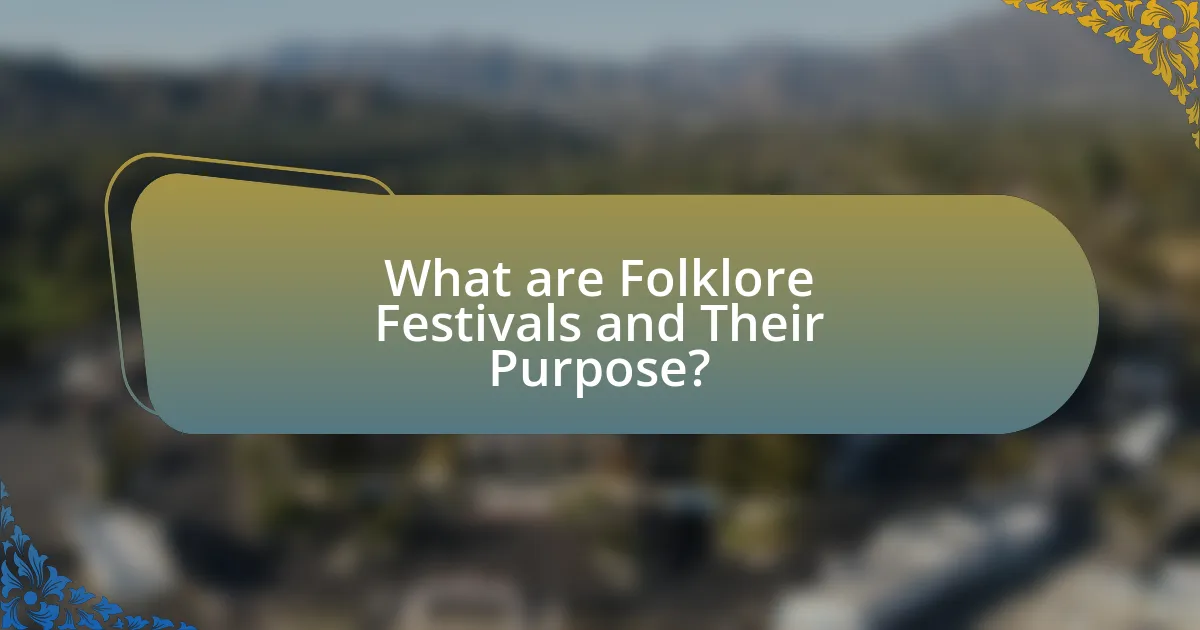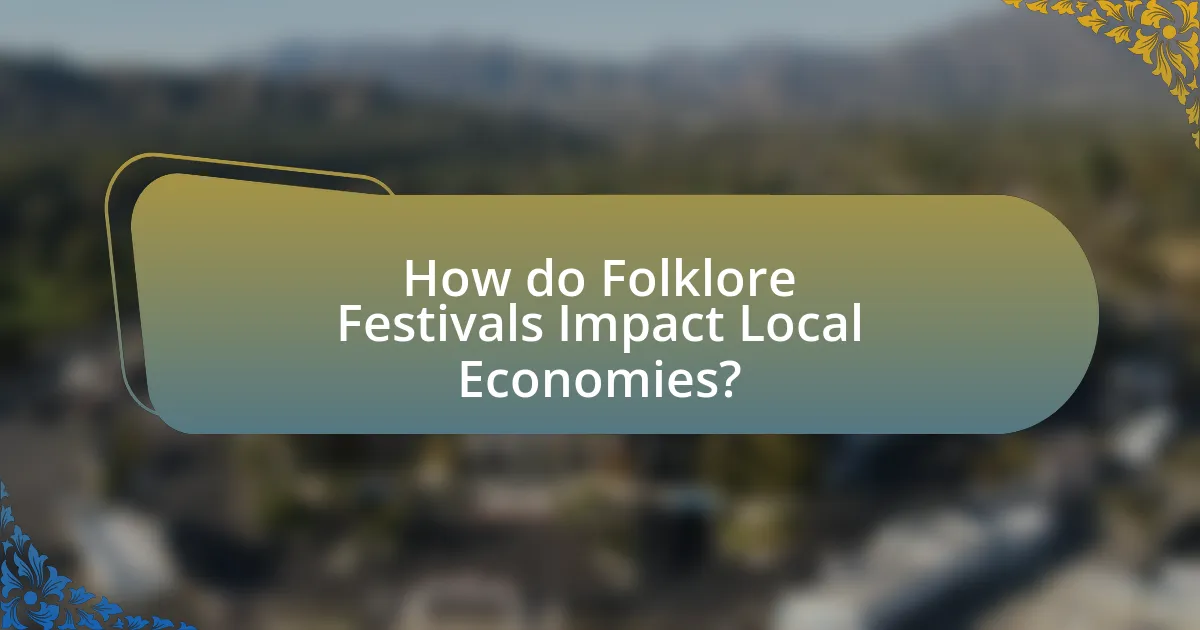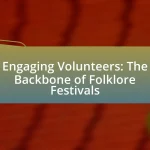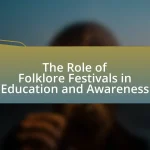Folklore festivals are cultural events that celebrate and preserve the traditions, stories, music, and arts of specific communities or regions. These festivals play a crucial role in promoting cultural heritage, fostering community identity, and enhancing local economies through increased tourism and job creation. The article explores how folklore festivals contribute to cultural preservation, showcase local traditions, and stimulate economic activity by attracting visitors and generating revenue for local businesses. Additionally, it addresses the challenges these festivals face, including funding limitations and competition, while highlighting innovative strategies for maximizing their economic impact.

What are Folklore Festivals and Their Purpose?
Folklore festivals are cultural events that celebrate and preserve the traditions, stories, music, and arts of a specific community or region. Their primary purpose is to promote cultural heritage, foster community identity, and provide a platform for artistic expression. These festivals often feature performances, workshops, and exhibitions that highlight local customs and folklore, thereby enhancing community engagement and tourism. For instance, the National Folk Festival in the United States showcases diverse cultural traditions, attracting thousands of visitors and contributing significantly to local economies through increased spending in hospitality and retail sectors.
How do Folklore Festivals contribute to cultural preservation?
Folklore festivals contribute to cultural preservation by serving as platforms for the transmission of traditional practices, stories, and art forms. These festivals showcase local customs, music, dance, and crafts, allowing communities to celebrate and maintain their unique cultural identities. For instance, the Smithsonian Folklife Festival in the United States highlights diverse cultural expressions, fostering appreciation and understanding among participants and audiences. This engagement not only reinforces community bonds but also educates younger generations about their heritage, ensuring that cultural knowledge is passed down. Additionally, folklore festivals often involve local artisans and performers, providing them with economic opportunities while simultaneously promoting the preservation of their cultural practices.
What traditions are typically showcased at Folklore Festivals?
Folklore festivals typically showcase traditional music, dance, crafts, and culinary practices. These festivals often feature performances of regional folk songs and dances, which reflect the cultural heritage of the community. Additionally, artisans display handmade crafts, such as pottery, textiles, and woodwork, emphasizing local craftsmanship. Culinary traditions are highlighted through food stalls offering regional dishes, allowing attendees to experience local flavors. The inclusion of storytelling and folklore presentations further enriches the cultural experience, providing insights into the history and values of the community.
How do these festivals promote community identity?
Festivals promote community identity by fostering a sense of belonging and shared cultural heritage among residents. These events often celebrate local traditions, arts, and history, which reinforces communal ties and collective memory. For instance, folklore festivals typically feature local music, dance, and crafts, allowing community members to engage with their cultural roots and express pride in their identity. Research indicates that participation in such festivals can enhance social cohesion, as seen in studies where communities reported increased interactions and strengthened relationships among residents during festival periods.
What role do Folklore Festivals play in local tourism?
Folklore festivals significantly enhance local tourism by attracting visitors who seek cultural experiences. These festivals showcase traditional music, dance, crafts, and cuisine, which not only promote local heritage but also stimulate economic activity. For instance, a study by the National Endowment for the Arts found that cultural events can increase local tourism revenue by up to 30%, as they encourage spending on accommodations, dining, and local attractions. Additionally, folklore festivals often lead to increased visibility for the host community, fostering repeat visits and long-term tourism growth.
How do festivals attract visitors to local areas?
Festivals attract visitors to local areas by offering unique cultural experiences that draw attention and participation. These events often showcase local traditions, arts, and cuisines, creating a vibrant atmosphere that appeals to both residents and tourists. For example, folklore festivals frequently feature performances, workshops, and local crafts, which enhance community engagement and promote regional identity. According to a study by the National Endowment for the Arts, cultural events can increase local tourism by up to 30%, demonstrating their significant impact on attracting visitors and boosting local economies.
What types of tourism are generated by Folklore Festivals?
Folklore festivals generate several types of tourism, primarily cultural tourism, heritage tourism, and event tourism. Cultural tourism attracts visitors interested in experiencing local traditions, music, dance, and crafts, which are prominently featured at these festivals. Heritage tourism focuses on the preservation and appreciation of local history and customs, drawing tourists who seek to connect with the cultural identity of a region. Event tourism is characterized by travelers who specifically plan their trips around the festival dates, contributing to increased attendance and economic activity in the host community. These types of tourism not only enhance visitor experiences but also stimulate local economies through spending on accommodations, food, and souvenirs.

How do Folklore Festivals Impact Local Economies?
Folklore festivals significantly boost local economies by increasing tourism, generating revenue, and creating jobs. These events attract visitors who spend money on accommodations, food, and local crafts, which stimulates various sectors of the economy. For instance, a study by the National Endowment for the Arts found that cultural events, including folklore festivals, can lead to a 20% increase in local business revenue during the festival period. Additionally, these festivals often require local staffing, thus creating temporary and sometimes permanent job opportunities in hospitality and event management. The overall economic impact can be substantial, with some festivals reported to contribute millions of dollars to their host communities.
What economic benefits do Folklore Festivals provide to local businesses?
Folklore festivals provide significant economic benefits to local businesses by increasing foot traffic and sales during the event. These festivals attract tourists and locals alike, leading to higher demand for goods and services such as food, accommodations, and crafts. For instance, a study conducted by the National Endowment for the Arts found that cultural events can boost local economies by generating millions in revenue, with some festivals reporting a 30% increase in sales for nearby restaurants and shops. This influx of visitors not only supports existing businesses but also encourages the establishment of new enterprises, thereby enhancing the overall economic landscape of the community.
How do vendors and artisans benefit from these festivals?
Vendors and artisans benefit from folklore festivals primarily through increased sales and exposure to a larger audience. These festivals attract significant foot traffic, allowing vendors to showcase their products directly to potential customers, which can lead to higher sales volumes. For instance, a study by the National Endowment for the Arts found that local artisans participating in community festivals reported sales increases of up to 30% during event weekends. Additionally, these festivals provide artisans with networking opportunities, enabling them to connect with other creators and potential collaborators, further enhancing their business prospects.
What is the impact on hospitality and service industries?
The impact on hospitality and service industries from folklore festivals is significant, as these events drive increased tourism and local spending. Festivals attract visitors who require accommodations, dining, and entertainment, leading to higher occupancy rates in hotels and increased revenue for restaurants and local businesses. For example, a study by the National Endowment for the Arts found that cultural events can boost local economies by generating millions in revenue, with attendees spending an average of $27 per person per day on services. This influx of visitors not only supports existing businesses but also encourages the development of new services and amenities, further enhancing the local economy.
How do Folklore Festivals influence job creation in local communities?
Folklore festivals significantly influence job creation in local communities by attracting tourists and stimulating local economies. These events generate employment opportunities in various sectors, including hospitality, retail, and entertainment, as local businesses prepare for increased visitor traffic. For instance, a study by the National Endowment for the Arts found that cultural events like folklore festivals can lead to a 20% increase in local employment during festival periods. Additionally, these festivals often require staffing for event management, security, and vendors, further contributing to job creation. Thus, folklore festivals serve as catalysts for economic growth and employment in their host communities.
What types of jobs are created during festival seasons?
Festival seasons create a variety of jobs, including event planning, hospitality, food service, entertainment, and retail positions. Event planners coordinate logistics, while hospitality roles encompass hotel staff and transportation services. Food service jobs arise from vendors and catering companies, and entertainment positions include performers and technicians. Retail jobs increase as local businesses sell festival-related merchandise. According to a study by the National Endowment for the Arts, festivals can generate significant employment opportunities, with some events creating thousands of temporary jobs in the local economy.
How do these jobs contribute to long-term economic stability?
Jobs created by folklore festivals contribute to long-term economic stability by generating consistent revenue streams for local businesses and fostering community engagement. These jobs, including those in event management, hospitality, and local artisanship, stimulate demand for goods and services, which in turn supports local employment and tax revenues. For instance, a study by the National Endowment for the Arts found that cultural events can increase local spending by up to 30%, demonstrating their significant impact on the economy. Additionally, the jobs associated with these festivals help to preserve cultural heritage, attracting tourism and enhancing the region’s appeal, which further solidifies economic resilience over time.

What Challenges Do Folklore Festivals Face in Economic Impact?
Folklore festivals face several challenges in achieving positive economic impact, primarily due to funding limitations, competition from other events, and fluctuating attendance. Funding limitations often hinder the ability to promote the festival effectively, leading to lower visitor numbers. For instance, a study by the National Endowment for the Arts found that many local festivals operate on tight budgets, which restricts their marketing reach and overall quality. Competition from other entertainment options can divert potential attendees, as festivals must compete with concerts, sporting events, and other cultural activities for audience attention. Additionally, fluctuating attendance due to weather conditions or economic downturns can significantly affect revenue, as seen in the case of the 2020 pandemic, which caused many festivals to cancel or reduce their scale, resulting in substantial financial losses. These factors collectively challenge folklore festivals in maximizing their economic contributions to local economies.
What are the financial challenges of organizing Folklore Festivals?
The financial challenges of organizing Folklore Festivals include securing adequate funding, managing operational costs, and ensuring profitability. Organizers often struggle to obtain sponsorships and grants, which are crucial for covering expenses such as venue rental, permits, and artist fees. According to a study by the National Endowment for the Arts, 60% of festival organizers report difficulties in attracting financial support, which directly impacts their ability to deliver quality events. Additionally, fluctuating attendance can lead to unpredictable revenue streams, making it hard to balance budgets and achieve financial sustainability.
How do funding and sponsorship affect festival sustainability?
Funding and sponsorship significantly enhance festival sustainability by providing essential financial resources that support operational costs and long-term planning. These financial contributions enable festivals to invest in infrastructure, marketing, and community engagement, which are crucial for attracting attendees and maintaining relevance. For instance, a study by the National Endowment for the Arts found that festivals with robust sponsorships reported a 30% increase in attendance, leading to greater economic impact on local businesses. Additionally, funding allows festivals to implement sustainable practices, such as waste reduction and eco-friendly initiatives, which can further enhance their appeal and longevity in the community.
What risks do organizers face in terms of attendance and revenue?
Organizers of folklore festivals face significant risks related to attendance and revenue, primarily due to factors such as weather conditions, competition from other events, and economic downturns. For instance, adverse weather can deter attendees, leading to lower ticket sales and reduced vendor revenue. Additionally, if multiple events occur simultaneously, potential attendees may choose to attend a competing festival, further impacting attendance numbers. Economic downturns can also reduce discretionary spending, causing potential attendees to prioritize essential expenses over festival attendance. These factors collectively threaten the financial viability of the festival, as evidenced by studies indicating that festivals with lower attendance often struggle to cover operational costs, leading to potential losses for organizers.
How can Folklore Festivals adapt to changing economic conditions?
Folklore festivals can adapt to changing economic conditions by diversifying funding sources and enhancing community engagement. By seeking sponsorships from local businesses and applying for grants, festivals can reduce reliance on ticket sales, which may fluctuate during economic downturns. Additionally, incorporating local artisans and food vendors can stimulate the local economy and attract more visitors, as evidenced by the success of the National Folk Festival in the United States, which reported increased local spending by integrating local culture and businesses into its programming. This approach not only sustains the festival but also strengthens community ties and boosts local economies.
What innovative strategies can be implemented to enhance economic impact?
Innovative strategies to enhance economic impact include leveraging digital marketing to promote folklore festivals, which can significantly increase attendance and local spending. For instance, utilizing social media platforms and targeted online advertising can reach broader audiences, as evidenced by a study from the National Endowment for the Arts, which found that effective marketing can boost festival attendance by up to 30%. Additionally, implementing partnerships with local businesses for sponsorships and cross-promotions can create a synergistic effect, driving both festival revenue and local economic growth. Research from the American Planning Association indicates that such collaborations can lead to a 15% increase in local business sales during festival periods.
How can festivals leverage technology for better engagement and revenue?
Festivals can leverage technology for better engagement and revenue by utilizing mobile apps, social media platforms, and data analytics. Mobile apps enhance attendee experience through features like schedules, maps, and ticket purchasing, leading to increased participation and spending. Social media platforms facilitate real-time interaction and promotion, driving ticket sales and attracting sponsors. Data analytics allows festivals to understand attendee preferences and behaviors, enabling targeted marketing strategies that boost revenue. For instance, a study by Eventbrite found that festivals using mobile technology saw a 20% increase in ticket sales compared to those that did not.
What best practices can be adopted for maximizing the economic impact of Folklore Festivals?
To maximize the economic impact of Folklore Festivals, organizers should implement strategic marketing, community engagement, and partnerships with local businesses. Effective marketing increases visibility and attracts a larger audience; for instance, targeted social media campaigns can reach diverse demographics, enhancing attendance. Community engagement fosters local participation, which can lead to increased spending in the area; studies show that festivals with strong local involvement see a 30% rise in economic benefits. Collaborating with local businesses creates synergies that boost the festival’s offerings and encourages attendees to spend on food, crafts, and services, further stimulating the local economy.















